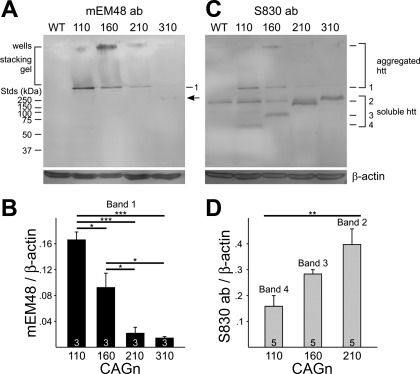Fig. 10.
A: Western blots of striatal extracts from 40-day-old mice using the mouse EM48 (mEM48) antibody (ab). Note the presence of 3 polypeptide bands: in the loading wells, at ∼300 kDa (band 1), and at ∼175 kDa [arrow; evident in the CAG310 mouse line; standards (Stds) are on the left of the blot]. Striata from 3 mice at each of the 4 different CAG repeat R6/2 lines, plus 2 WT counterparts, were analyzed. B: intensities of the ∼300-kDa aggregated band (band 1) for each CAG repeat line were normalized to β-actin, and means (±SE) are plotted. Significance is indicated by *P < 0.05, ***P < 0.001. C: Western blots of striatal extracts from 21-day-old mice using the S830 antibody. Likely aggregated huntingtin (htt) is detected again in the wells and at ∼300 kDa, 1,046 corresponding to band 1, previously detected with mEM48 antibody in A. New bands 2, 3, and 4, corresponding in size to ∼120, 90, and 60 kDa, respectively, soluble forms of htt, are uniquely expressed in the CAG210, CAG160, and CAG110 R6/2 mouse lines, respectively. An additional, soluble htt band, similar in size to the ∼175 kDa detected with the mEM48 antibody (A), was also evident in the CAG310 line but was not quantified due to an obscuring nearby common band found in the WT fractions. Striata from 5 mice of each of the 4 different CAG repeat R6/2 mice were analyzed. D: intensities of the bands 2, 3, and 4 uniquely detected in each of the CAG210, 160, 110 repeat lines, respectively, were normalized to β-actin and means (±SE) plotted. Significance is indicated by **P = 0.007.

